七年级英语下册Unit 4 Finding your way Period 6 Study skills学案新版牛津版
7B Unit4 Finding your way知识点整理

Unit4 Finding your way跟着我follow me上去/下来go up/down确定/确信be sure害怕be afraid必须,不得不have to=must指一个地方在另一个地方范围外的相对位置be +方向+of = to the+方向+of指一个地方在另一个地方范围内的相对位置in the+方向+of远离,离……远far away from去旅行1)go for a trip "for"往往指“为了”,该词组侧重讲为了旅游去的,往往指“去旅行”状态一般是没去,打算去2)go on a trip 侧重于讲状态,“在旅游”这个词组一般是说已经去旅行了三千米three kilometres径直走go straight on整天躺着lie down all day long来这儿看他们come here to see them沿着这条路走walk along the road动物世界的国王kings of the animal world发出动听的声音make beautiful sounds猴子的森林Monkeys’ Forest四处窜jump around使人大笑make people laughmake 的用法:1)使某人做make sb. do2)使某人或某物怎么样make sb./sth. adj(形容词)吃来自树上的树叶eat the leaves from trees穿过桥cross the bridge= walk across the bridge旅行愉快have a nice trip在树上in the tree (外来物)on the tree (长在树上)在两棵树之间between the two trees找到宝藏find treasure在第二个路口朝右转take the second turning on the right=turn right at the sencond turning一个英语角an English corner你愿意来吗是的,我很乐意。
七年级英语下册Unit4Findingyourway知识点归纳

七年级英语下册Unit4Findingyourway知识点归纳七年级英语下册Unit4Findingyourway知识点归纳下 Unit 4 知识点归纳1 find your way 找到你的路2 跟我来3 be sure 确信4 be afraid 害怕、恐怕5 There’s a path between the hills.⼭之间有条⼩径。
6 go up/go down 上去/下来7 have to 不得不8 go on a trip/have a trip 进⾏⼀次旅⾏9 be east/west/south/north of 在……东/西/南/北部10 be far away from 远离11 about 3 kilometres away 约3公⾥远12 get there by bus/take the bus there 坐汽车到那⼉13 go to …for the class trip 去某地班级旅⾏Reading (P. 44~46)1 a trip to the zoo 去动物园的旅⾏2 Here we are. 我们到了。
3 in front of South Gate 在南⼤门的前⾯4 Go straight on ,and you’ll find the Panda House. 直⾛,你就会找到熊猫馆。
5 like to eat bamboo 喜欢吃⽵⼦6 lie down all day long 整天躺着7 Every year, lots of visitors co me here to see them. 每年,许多游客来这⼉看他们。
8 walk along the road 沿着这条马路⾛9 To the north of the Panda House, you’ll find the lions. 在熊猫馆的北边,你会看到狮⼦。
10 Lions are the kings of the animal world. 狮⼦是动物世界之王。
【牛津版】七年级英语下册 Unit 4 Finding your way IPS教案
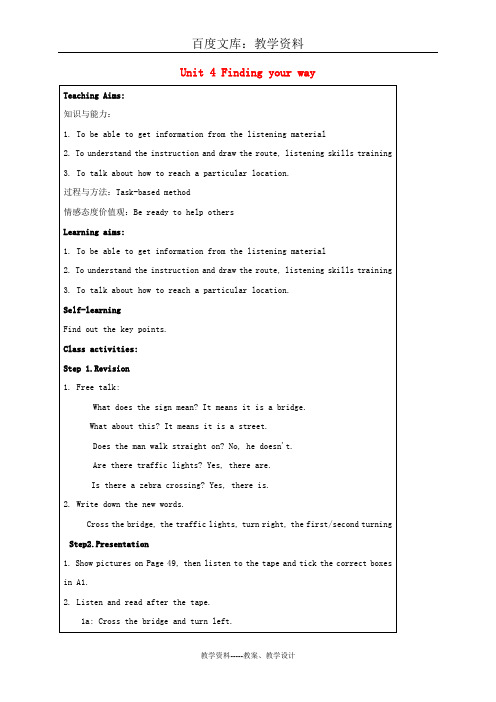
Is there a zebra crossing? Yes, there is.
2.Write down the new words.
Cross the bridge, the traffic lights, turn right, the first/second turning
Step2.Presentation
1.Show pictures on Page 49, then listen to the tape and tick the correct boxes in A1.
2.Listen and read after the tape.
1a: Cross the bridge and turn left.
Step 4 Pair workቤተ መጻሕፍቲ ባይዱ
Work in pairs and tell your partner how to get to a place. and use the conversation Part B on Page50 as a model.
IV. Summary
1.The new words and useful expression
Class activities:
Step 1.Revision
1.Free talk:
What does the sign mean? It means it is a bridge.
What about this? It means it is a street.
Does the man walk straight on? No, he doesn't.
7B_Unit_4_Finding_your_wayYH

To get to the Zoo, turn left when you come to the crossroads. The entranceis on your left.When you come to the corner of the road, turn right and you’ll see a hotel.Cross the road and you’ll see the museum.Period 1 Comic strip & Welcome to the unitTeaching goals●To introduce the topic of places and transport●To activate existing vocabulary and identify the meanings of new wordsrelated to the topic●To guess meaning from pictures●To talk about visits and means of transport using model sentencesTeaching proceduresStep 1 Presenting1. (show them a picture about the birds flying to the south)T: Where do birds fly in autumn?S: They fly to the south.T: Where do they fly in spring?S: They fly back to the north.Get them ready for the words about directions.2. Show them the chart about directions.north-west, north, north-east, west, east, south-west, south, south-eastT: Can you say the directions out with correct words?S:…T: Now please read these words after me for two times.S:…3. T: Now I want you tell us something about your living community. You can tell your partners about your own community. You must use some words about directions. You can draw a picture first.(a hospital, a restaurant, a supermarket, a school, a bus stop, a hotel, a shopping mall…)S:…Step 2 Presenting1. Take one picture from the student and ask the others.T: Where is the hospital/restaurant/hotel…?S: The hospital is north/east/… of my house.2. The students can work in pairs and ask each other some questions. e.g.S1: Where is the supermarket?S2: The supermarket is …3. Ask several pairs to do the dialogue.4. T: Now I have a question. How do you usually go to school?S: I usually go to school by bike/ by bus / on foot…1.Ask students to make up new dialogues using different transport means, thenask them to role-play it.Step 3 Presention1.T: The Class 1, Grade 7 students are planning a spring outing. Read the instructions. Look at the map and find the places they plan to visit. Then write the numbers in the boxes. (The teacher read the three sentences to them and let them write down the correct numbers)2. T: How can we get to the Park Lake/ the Zoo/ the Sunnyside Garden?S: Let’s go there by bus/underground…T: We also can use other expressions to give suggestions.Why don’t we…?What about …?Why not…?T: Now please work in pairs and make up a new dialogue, and then ask them to role-play it.S:…Step 4 Practicing1. Show them a picture and ask them work in a group of four students.S1: Where is the park/…?S2: The park/… is …S1: Let’s go to the park/…S2:OK.S1:How can we go there?S2:We can go there by bus/on foot/…2. Ask some pairs to practice the dialogue.Step 5 Presenting1. Ask the students to look at the comics on page 42.T: Hobo and Eddie are going to a spring outing. Now please listen to the tape and answer the questions.Where are Hobo and Eddie standing? (On top of a hill.)How does Hobo go down the hill? (Hobo jumps down.)What does the sign say? (It says ‘Dogs this way’.)Do they have to go up the hill again? (Yes, they do.)2. T: Now please listen to the tape.3. T: Ok, let’s read the dialogue together.S:…4. T: Now, I’ll give you 2 minutes to read the dialogue with your partner. Then I’ll invite some of you to come to the blackboard and role-play it.Step 6 Doing homework1. Read the dialogue after class.2. Recite the new words and the structures today.3. Finish the exercises on the workbook.Period 2 Reading (Ⅰ)Teaching goals●To infer meaning from keywords, context and existing knowledge●To understand a series of events and simultaneous actions.●To identify specific details by following a route and marking points on a map.Teaching proceduresStep 1 RevisionReview the words about directions.Step 2 Presenting1. T: Look at me. Can you try to guess what I am doing? (push, pull.)2. T: I have some more new words, please look at these pictures and tell me what they are.(police station, police uniform, robbers, green van, traffic lights, knife, building)3.Then make up a new dialogue with these words.T: Look! There is a building. It’s a police station. In the police station, there are three robbers. They are in police uniform. There is a green van nearby. In the van there is a knife. The policemen find the robbers at the traffic lights.Why are the three robbers in police uniform in the police station? Can you guess?T: Now please look at the picture on page 46 C2 . Can you find the following places?(restaurant, hotel, Hill Building, police station, Park Road, 4th Street, 5th Street, 6th Street, 7th Street,8th Street)4. T: Ok, you know about the places, let’s do part B1 on page 45.Step 3 Reading1.T: Now please listen to the tape, and try to answer the questions.How many people are there in the story?Who are they? (the twin brothers, Susan, and the policeman.)Do the twins go to the police station? (Yes, they do.)2.T: Ok, you can open your book now and check the answers.Please read the text quickly and answer the following questions.Who is making a call to the twin brothers? (Susan.)Where are the robbers? (They are in Hill Building.)How do the twins go to Hill Building? (They drive there.)What do the robbers push the twins into? (They push them into a van.)How do the twins open the back door of the van? (They use a knife.)Who do the twins see at the police station? (They see the robbers.)Step 4 Reading1. Now please work in a group of 4 students. Try to draw out Justin’s and Paul’s route to the police station on the map. ( check the answers)2. T: Let’s look at these True or False questions, and write T if it is true, write F if it is false.The twins use a knife to open the back door of the van. (T)The twins run to the police station on 5th Street. ( F)When the van stops at Hill Building, the twins jump out of it at once. (F)Justin and Paul take different routes to the police station. (T)At the police station, the twins are happy to see the robbers. (F)The twins catch the robbers. (F)Check the students’ answers and provide help if necessary.3.Now please read after the tape for one time.4.Please work in a group of 4 students, each student read one person.(Susan, policeman, Justin, Paul) Ask the best group to show their play to the others.5.Finish the exercises of B2 on page 45 and C1 on page 46.Step 5 SummaryToday we learned about the story of a robbery, now please read the story again.Step 6 Doing homework1. Read the text familiarly and try to recite it if possible.2. Ask my students to try to tell the story in their own words.Period 3 Reading (Ⅱ)Teaching goals●To understand and use the expressions in the text●To retell the story in their own wordsTeaching proceduresStep 1 Presenting1.In the story, there are many useful words and expressions. Today, let’s learn them together.get a call接到一个电话; robber抢劫犯; drive to…开车前往……;ride to…骑车前往……;walk to …走路前往……; run to…跑步前往……;fly to …坐飞机前往……; get out of … 从……地方出来; ran out of…从……地方跑出来; jump out of …从……地方跳出来;look out of…向……外面看;at once= right now 立刻,马上;three men in police uniform 三个穿警服的人;push… into the van推进;drive away开车离开;run away跑开2.Paul try to open the door but failed.我尽力赶早班车,但没赶上.3.It works.My computer doesn’t work. There must be something wrong with it.4.He uses a knife to open the door. He opens the door with a knife.5.take different routes (to)…/ take this route (to)…6.turn left/right into (to) …Road/Street7.go/walk along … Street8.The van stops at the traffic lights. Suddenly, Justin stops talking9.We stop the van. stop doing sth.10.He is surprised to see the three men in the police station.He is very happy to see his dearest grandma again.I am very sorry to hear the bad news.11.They try to run away but we catch them in the end.in the end=at last=finallyStep 2 Consolidation exercises1. Translationl. The man ________ (穿着警察制服) is Daniel’s uncle. (in police uniform)2. Every morning my father _________ (开车带我去) school. (drives me to)3.Lucy ________(跑出) the classroom after school. (runs out of)4.Everyone ___________(吃惊地看见)see a big cat when it ________(跳出) the box.( is surprised to, jumps out of )5.Policemen often help students cross the road___________(在交通灯处). (at the traffic lights)6.Shall we ___________(走不同的线路)to the shopping mall? Let’s see who is faster. (take different routes)2. Translation1) 保罗试图打开门,但是没有成功。
七年级下册英语Unit4Findingyourway教案(牛津版)
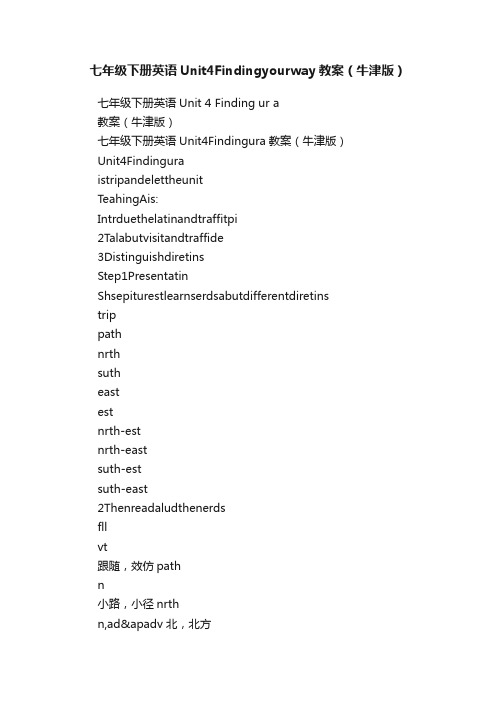
七年级下册英语Unit4Findingyourway教案(牛津版)七年级下册英语Unit 4 Finding ur a教案(牛津版)七年级下册英语Unit4Findingura教案(牛津版)Unit4FindinguraistripandelettheunitTeahingAis:Intrduethelatinandtraffitpi2Talabutvisitandtraffide3DistinguishdiretinsStep1Presentatin Shsepiturestlearnserdsabutdifferentdiretinstrippathnrthsutheastestnrth-estnrth-eastsuth-estsuth-east2Thenreadaludthenerdsfllvt跟随,效仿pathn小路,小径nrthn,ad&apadv 北,北方estn,ad&apadv 西,西方suthn,ad&apadv 南,南方eastn,ad&apadv 东,东方tripn旅行,旅游iletre=n千米,公里havet不得不,必须Step2Pratise PratiseinpairsliethisttalabutheretheplaeisA:hereis…?(旅游)?B:It’snrth/suth/east/estf…2AsstudentstpletePartAnPage43Step3Presentatin PresentsepituresfrSstlearnhtgetthereThenasSstaesedi algues Step4Listenandanser ListentpartBandanserthefllingquestin herearethegingfrtheirlasstrip?hereisthez?Hillthegetthere?2Readafterthererder3Pratieinpairs4AtitutaetheirndialgueStepLearnthenversatinListentthetapeandas:)hereareHbandEddiestanding?2)hatdesHbasEddietdinthepiture?3)Dthehavetgupthehillagain?4)DesHbreallnthea?es:Thearenthetpfthehill2Heasshitgdnthehill3es,thed4N,hedesn’t2AtutthenversatinStep6Explanatin方位介词的用法小结benrth/suth/est/eastf在……北部/南部/西部/东部benrth-east/suth-estf在……东北部/西南部benrth-est/suth-eastf在……西北部/东南部AisinthefBAisnthe…fBAistthe…fB(A与B不接壤)2beafraidfdingsth/fsth害怕做某事beafraidthat…I’afraid…Step7ExerisesTranslatin别这么肯定。
初中英语 牛津译林版七年级下册 Unit 4 Finding your way 知识点
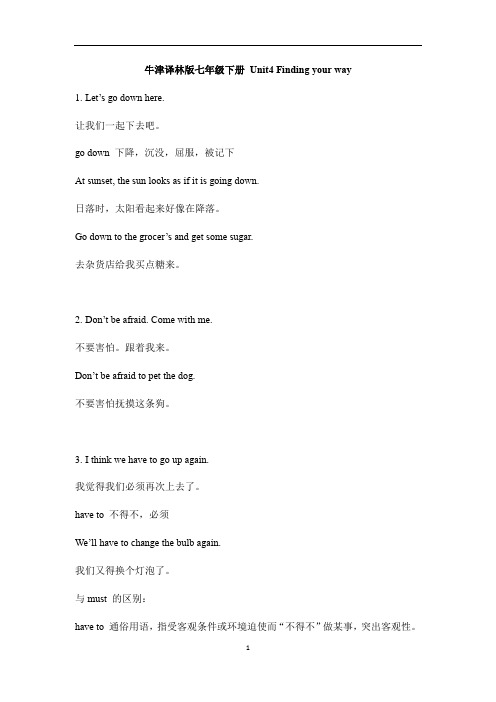
牛津译林版七年级下册Unit4 Finding your way1.Let’s go down here.让我们一起下去吧。
go down 下降,沉没,屈服,被记下At sunset, the sun looks as if it is going down.日落时,太阳看起来好像在降落。
Go down to the grocer’s and get some sugar.去杂货店给我买点糖来。
2.Don’t be afraid. Come with me.不要害怕。
跟着我来。
Don’t be afraid to pet the dog.不要害怕抚摸这条狗。
3.I think we have to go up again.我觉得我们必须再次上去了。
have to 不得不,必须We’ll have to change the bulb again.我们又得换个灯泡了。
与must 的区别:have to 通俗用语,指受客观条件或环境迫使而“不得不”做某事,突出客观性。
must 通常表示命令或说话人主观认为必须要做某事,含强调语气,侧重主观性。
I have to have someone to look after.我必须去照顾某人。
Then you must be my cousin.那么你一定是我的远亲了。
go up 增长,建起,炸毁Go up to the fork and turn left.走到岔口处向左拐。
Production is going up in leaps and bounds.产量飞速增长。
4.Sunshine Zoo is north of Sunshine Middle School.阳光动物园在阳光中学的北面。
be + 方位词+ of ... (某地)在(另一地)的......方向Our school is south of the zoo.我们学校在动物园的南面。
英语中东南、东北、西南和西北的表达分别是south-east, north-east, south-west, north-west。
七年级英语下册Unit4FindingyourwayCW教案(新版)牛津版

.---OK. We can gobyห้องสมุดไป่ตู้bus.
Language points:
1. The zoois north ofBeijing Sunshine Secondary School. (north of)
south, west, north-west, south-west
4. be afraid to do.
5. be afraid of sth./doing sth.
6.I’m afraid that+从句
e.g. (1) The little girl is afraid to go out in the evening.
(2) Little Tom is afraid of dogs.
Teaching task:
1.To introduce the topic of places and transport.
2.To talk about visits and means of transport using model sentences.
Teaching aids:tape recorder
Finding your way
Teaching aims and demands:
New words:follow, path, have to, north, west, south, east, trip, kilometer
Teaching methods:task-based approach
2. Listen again, Ss read after the tape recorder, then do some True or False exercises. Check the answers with the whole class.
七年级英语下册 Unit 4 Finding your way IPS教案 (新版)牛津版

1.Remember the lesson learned vocabulary and phrases.
2.Recide or act the conversation
3. write a dialogue with the information
4. Preview Study skills.
Class activities:
Step 1.Revision
1.Free talk:
What does the sign mean? It means it is a bridge.
What about this? It means it is a street.
Does the man walk straight on? No, he doesn't.
Unit 4 Finding your way
Teaching Aims:
知识与能力:
1. To be able to get information from the listening material
2. To understand the instruction and draw the route, listening skills training
2. Listening skills training
Step 5. Exercises
一.选择所给单词的正确形式填空。
1)Jack’s grandfather lives in a(wood/wooden)house in the small village.
2) You can take the(second/two)turning on your right.
七年级英语下册 Unit 4 Finding your way教案 (新版)牛津版-(新版)牛津版初

Unit 4 Finding your wayTeaching aimI. To let the students recognize and master the key expressions about directions. II. To let the students develop intensive listening skills by following instructions and and marking a route.III. To let the students understand directions in a new context of finding a hidden treasure, and use key information given in instructions and identify the specific order of them from listeningTeaching proceduresStep 1. RevisionI. Let the students watch a period of video to arouse the topic today --- finding the way.II. Show some pictures which were taken in the street and ask the students to talk about them.III. Let the students have a petition about the road signs.Step 2. PresentationI. Show some pictures with the simple instructions and let the students discuss them in pairs and choose the right picture, then teach them some simple instructions --- the way of showing the route.II. Show the route (from Yufeng Experimental school to Kunshan Bus Station) to the students and teach them how to express the route in English.Step 3. PracticeShow the students another route (from WujiangExperimentalSchool to Wujiang TV Tower )and let them practice expressing the route.Step 4. ConsolidationI. Let the students listen to a dialogue and answer two simple questions.II. Check the answers with the students and then let the students read the dialogue in different roles.III. Let the students make their own dialogues with the partner according to the sample dialogue.Step 5. Playing a game --- Treasure HuntLet the students look at a map and guess where the treasure is.Draw the route while listening to the tape and try to find the treasure.Listen to the tape again and put the sentences into the correct order with the help of the route they draw.Check the order and the route with the students.Step 6. HomeworkPlease draw a route which is from your home to a place you like and express it in English.。
7B课文翻译Unit4 Finding your way Reading
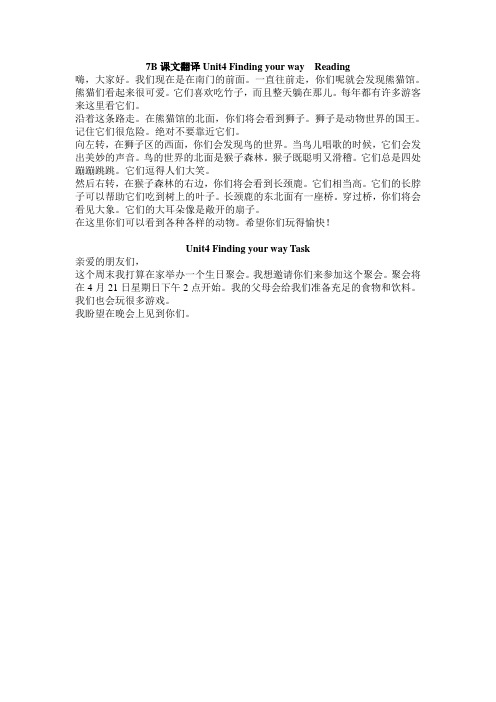
7B课文翻译Unit4 Finding your way Reading
嗨,大家好。
我们现在是在南门的前面。
一直往前走,你们呢就会发现熊猫馆。
熊猫们看起来很可爱。
它们喜欢吃竹子,而且整天躺在那儿。
每年都有许多游客来这里看它们。
沿着这条路走。
在熊猫馆的北面,你们将会看到狮子。
狮子是动物世界的国王。
记住它们很危险。
绝对不要靠近它们。
向左转,在狮子区的西面,你们会发现鸟的世界。
当鸟儿唱歌的时候,它们会发出美妙的声音。
鸟的世界的北面是猴子森林。
猴子既聪明又滑稽。
它们总是四处蹦蹦跳跳。
它们逗得人们大笑。
然后右转,在猴子森林的右边,你们将会看到长颈鹿。
它们相当高。
它们的长脖子可以帮助它们吃到树上的叶子。
长颈鹿的东北面有一座桥。
穿过桥,你们将会看见大象。
它们的大耳朵像是敞开的扇子。
在这里你们可以看到各种各样的动物。
希望你们玩得愉快!
Unit4 Finding your way Task
亲爱的朋友们,
这个周末我打算在家举办一个生日聚会。
我想邀请你们来参加这个聚会。
聚会将在4月21日星期日下午2点开始。
我的父母会给我们准备充足的食物和饮料。
我们也会玩很多游戏。
我盼望在晚会上见到你们。
译林牛津版七年级下册英语Unit 4 Period 2 Reading

④Birdsmakebeautifulsoundswhentheysing.
考点4 sound/saʊnd/n. 声音 e.g. Wecan’thearanysound. 我们一点声音都听不到。
一语辨异:Icouldhardlyhearanysoundexcepthis voicebecausenoonemadeanoise. 除了他的说话声,我几乎听 不到任何声音,因为大家都很安静,没有任何的嘈杂声。
Thestoryisamazing, soIcanrememberit.
这个故事很令人吃惊, 因此我能记住它。
remember+ 名词/ 代词, 表示“记得……”。
Pleaseremembertoturnoffthelightswhenyouleave. 当你离开的时候请记得关灯。remember to do sth. ,记着
B2HerearesomedescriptionsaboutSunshineZoo. WriteaTifasentenceistrueoranFifitisfalse.
1ThestudentsstarttheirvisitfromtheNorthGate. _______ 2Pandasdonotliketoliedownalldaylong. _______ F 3Visitorscannotgonearthelions. _______ F 4Thebirdsinthezooareveryquiet. _______
B4MillieistellingherfriendWendyonlineaboutSunshineZo o. Completetheirconversationwiththeinformationonpage 44.
+Unit+4+Finding+your+way+知识点汇总 牛津译林版七年级英语下册

7BUnit4 Finding your way 知识点汇总一、Comic strip and Welcome to the unit.1. follow me 跟我来【=come with me】【拓展】following 形容词:接下来的、以下的the following week = the next week 下一周2. Are you sure?你确定吗?【复习】be sure 用法:(1)be sure of/about sth. (2)be sure to do sth.(3)be sure +(that)宾从3.Let's go on a trip. 让我们去旅行。
【重点】go on a trip to sp. = travel to sp. = go to sp. for a trip 去某地旅行4.have to go up again 不得不再上去5.Sunshine Zoo is north of Sunshine Middle School.【重点】表示“A在B的东/南/西/北面"用句型:A is east/south/west/north of B其同义句是(另一种表达方式):A is to/on the east/south/west/north of BEg: Nanjing is west of Shanghai=Nanjing is to the west of Shanghai表示方位的介词in.on与to的区别:(1)in 表示A在B的范围之内,Jiangsuis in_the south ofChina.江苏在中国南部。
(2)to 表示两者不接壤,在范围以外,不是从属关系:Japanis to the east ofChina. 日本在中国东面.(3)on 表示两地接壤,在范围以外,不是从属关系:Russia is on the north ofChina. 俄罗斯在中国北面。
七年级英语下册知识讲义-Unit 4 Finding your way!-牛津译林

一、学习目标1. 知识目标:A. 学会重点词汇:follow, north, west, south, east, trip, kilometer, everybody, straight, bamboo, along, road, king, remember, that, dangerous, sound, forest, funny, laugh, giraffe, quite, neck, leaf(pl. leaves), north-east, bridge, cross, across, inside, outsideB. 学会重点短语:go down, come with me, have to, go up, go on a trip, be north of, lie down, all day long, turn left, to the east of…, half an hour laterC. 学会句型:Don’t be afraid. Come with me. I think we have to go up again.Sunshine Zoo is north of Sunshine Middle School.Is it far away from our school?Go straight on and you’ll find the Panda House.Birds make beautiful sounds when they sing.They jump around and make people laugh.Their ears are like open fans.2. 能力目标:A. 能够正确使用四会词汇,并熟练地掌握好这些词汇的基本用法。
B. 能够正确地指路,说出到某地怎么走。
二、重点、难点重点:掌握重要词汇和短语以及重点句型。
难点:灵活使用重要的短语和句型,并能说出到某地怎么走。
7B U4《 Finding your way》教学设计-优秀教案
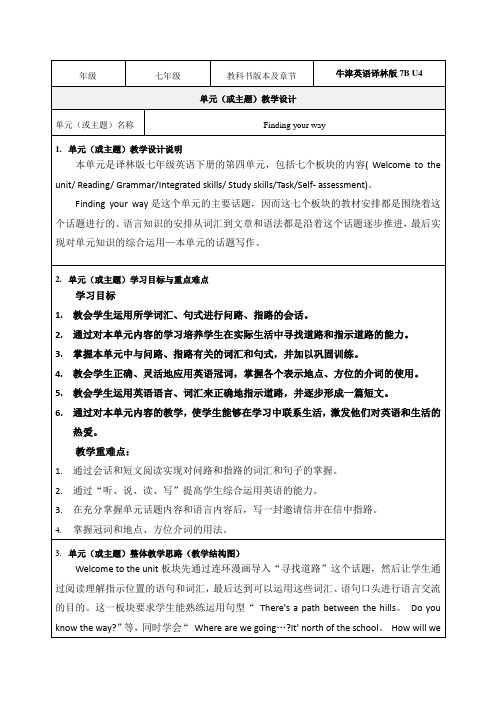
10. 教学反思与改进
本节课学生课堂学习兴趣极高,对动物感兴趣。同时符合学生出行旅游的实际,有助于帮助学生表达 英语指路用语。学生在课堂上表现积极,可以在课后寻找大家熟悉的旅游景区的地图,鼓励学生试着 用所学知识表达指路,巩固所学,增强应用能力。
习题/试卷讲评课□ 学科实践活动课□ 其他□
1. 教学内容分析
Reading 板块则是以学生到动物园去游览为主题,以导游向大家指示旅游路线为线索, 使学生进一步接触、了解指引道路的语句,同时进一步掌握、运用这些指示道路的词汇和 句子。在文章预读上则是通过一些有趣的阅读练习提高学生的阅读兴趣,达到在积极有效 的学习氛围中提高学生阅读能力的效果。
年级
七年级
教科书版本及章节 单元(或主题)教学设计
牛津英语译林版 7B U4
单元(或主题)名称
Finding your way
1. 单元(或主题)教学设计说明
本单元是译林版七年级英语下册的第四单元,包括七个板块的内容( Welcome to the unit/ Reading/ Grammar/Integrated skills/ Study skills/Task/Self- assessment)。
Self- assessment 板块要求学生对照本单元的各个学习项目进行自我测评,然后进行自 我反省对本单元知识的掌握情况,对于不足和缺点要制定有效的计划改善、提高。
课题
第 1 课时教学设计(其他课时同) Finding your way (reading)
课型
新授课
章/单元复习课□ 专题复习课□
热爱。 教学重难点: 1. 通过会话和短文阅读实现对问路和指路的词汇和句子的掌握。 2. 通过“听、说、读、写”提高学生综合运用英语的能力。 3. 在充分掌握单元话题内容和语言内容后,写一封邀请信并在信中指路。 4. 掌握冠词和地点、方位介词的用法。
中学七年级英语下册Unit4Findingyourway教案
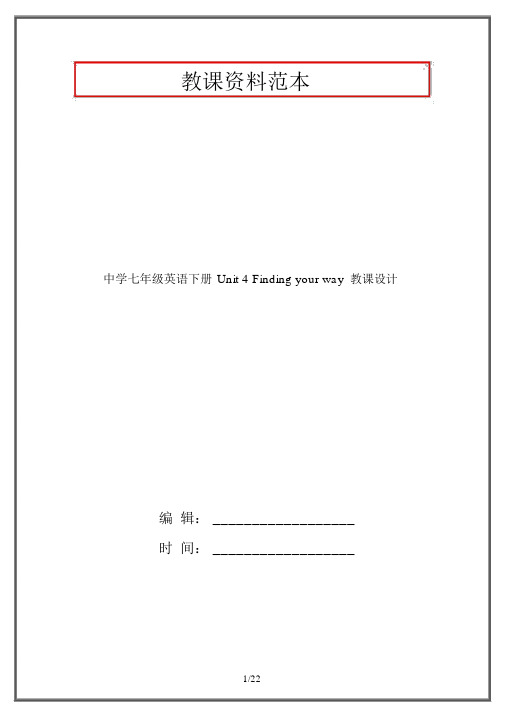
教课资料范本中学七年级英语下册Unit 4 Finding your way教课设计编辑: __________________时间: __________________Unit 4 Finding your way 课题Unit 4 Finding your way1.能认识有关地址和交通的图标。
教课目的 2.能讨论出游和交通方式的话题。
3.能鉴别方向。
教课要点能在讲堂活动顶用简洁的英语进行社交。
能就熟习的话题进行简单的沟通。
教课难点能在教师的指导下参加简单的游戏和角色饰演活动。
能供给有关个人状况和个人经历的信息。
教学过程(教课环节、教师活动、学生活动)Step Ⅰ Free talk1.Ask and answer:(about directions)Where do some birds fly in winter?Where do they fly in spring?2.New words: south north east west south-east north-west south-west north-east.3.Ask and answer:Where’s the park?The park is north of our school.Step Ⅱ Practice1.Draw a map, then ask and answer.Where’s ? It ’s .2.Ask students to act in front of the class.3.Text book P43 Part AThe students are planning a class trip. Look at the map.First, tell me where Sunshine Middle School is. Thenfind the places they plan to visit.Step Ⅲ Presentation1.Ask and answer questions like this:Is your home far from our school?How do you usually go to school? 总第1课时二次备课2.Practice: Ask student ’s to make a similar dialogue like this:S1: Is your home far from our school?S2: No. It ’s north of the school, about ten miles away.3.Simon and Daniel are talking about the trip. Listen tothe tape and answer these questions.Where are they going for the trip?Where ’s the zoo?How will they get there?4.Open your books. Please repeat the conversation afterthe tape.Step PracticeWork in pairs and talk about the trip. You can use Simon and Daniel ’s conversation as a model. S1: Where’s Sunshine Park?S2: It ’s north-east of our school.S3: Let ’s go t here.S2: OK.S1: How can we get there?S2: We can get there by bus/on foot.Step PresentationWork in pairs. Suppose one knows the way, and the other doesn’t. Please have a conversation about this. eg: I know the way. Follow me!Are you sure?Don’ t be afraid. Come with me.Step Listen and answer1.Listen to the tape and answer the question:Does Hobo, in fact, know the way?(No, he doesn ’t.)2. (1)Where are Hobo and Eddie? (They’re on a hill.)(2)How does Hobo go down the hill?(Hobo jumps down.)(3)What does the sign say? (It says’Dogs this way’.)(4)Do they have to go up the hill again? (Yes, they do.) Step Read and act1.Listen again, Ss read after the tape recorder.2.Ask some students to act it out, and they can usetheir own ideas in the conversation.Step Homework1.Recite the dialogue and Part B.2.3.Preview Reading.3/22年级:初一学科:英语备课时间:课题Reading (I)总第 2课时1.能依据地图识路,掌握方向的基本表达方法。
牛津译林版英语七下词汇默写:Unit4Findingyourway(学生用)
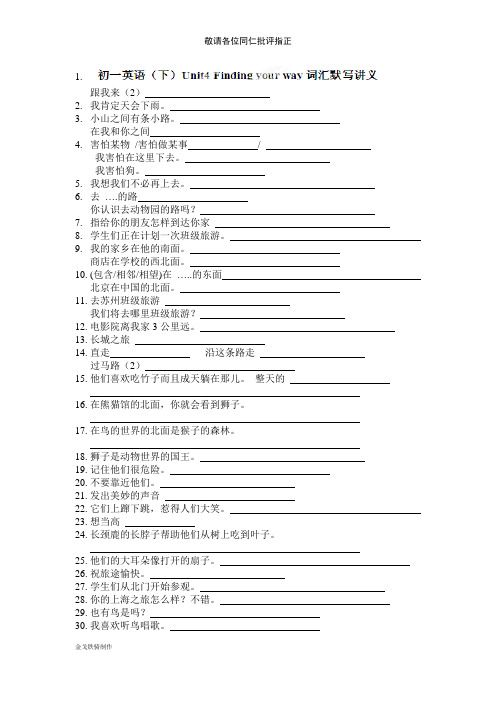
1.跟我来(2)2.我肯定天会下雨。
3.小山之间有条小路。
在我和你之间4.害怕某物/害怕做某事/我害怕在这里下去。
我害怕狗。
5.我想我们不必再上去。
6.去….的路你认识去动物园的路吗?7.指给你的朋友怎样到达你家8.学生们正在计划一次班级旅游。
9.我的家乡在他的南面。
商店在学校的西北面。
10.(包含/相邻/相望)在…..的东面北京在中国的北面。
11.去苏州班级旅游我们将去哪里班级旅游?12.电影院离我家3公里远。
13.长城之旅14.直走沿这条路走过马路(2)15.他们喜欢吃竹子而且成天躺在那儿。
整天的16.在熊猫馆的北面,你就会看到狮子。
17.在鸟的世界的北面是猴子的森林。
18.狮子是动物世界的国王。
19.记住他们很危险。
20.不要靠近他们。
21.发出美妙的声音22.它们上蹿下跳,惹得人们大笑。
23.想当高24.长颈鹿的长脖子帮助他们从树上吃到叶子。
25.他们的大耳朵像打开的扇子。
26.祝旅途愉快。
27.学生们从北门开始参观。
28.你的上海之旅怎么样?不错。
29.也有鸟是吗?30.我喜欢听鸟唱歌。
31.我们在这儿。
这里有座桥。
32.它正躺在草地上。
33.多可爱的熊猫!(2)34.小熊猫看起来不像它的妈妈。
35.在空地住在大笼子里36.半小时后37.桥对面你能看到什么?38.售货员在商店里面。
39.食物在饮料上方.我住在他楼下三层。
40.长凳在指示牌下方。
桥在河上方。
41.鸟在树上。
苹果在树上。
42.大门的左面有一个厕所。
43.在长椅上聊天44.一只鞋在门后,另一只鞋在床下。
45.走过桥46.走过警察局左拐/右拐/沿着湖边的小路往前走47.沿着小路走,你将会在左手边看见一间屋子。
48.朝着桥走49.宝藏在左边第三棵树前面的地底下。
50.第二个路口右拐(2)51.我怎么到那里?常用的问路表达法:52.街拐角的一个英语角在房间的角落53.出去走出公园54.在交通灯处我该走那条路?55.在第一个十字路口左拐56.一封邀请信57.我想要邀请你参加聚会。
七年级下册英语Unit 4 Finding your way教案牛津版
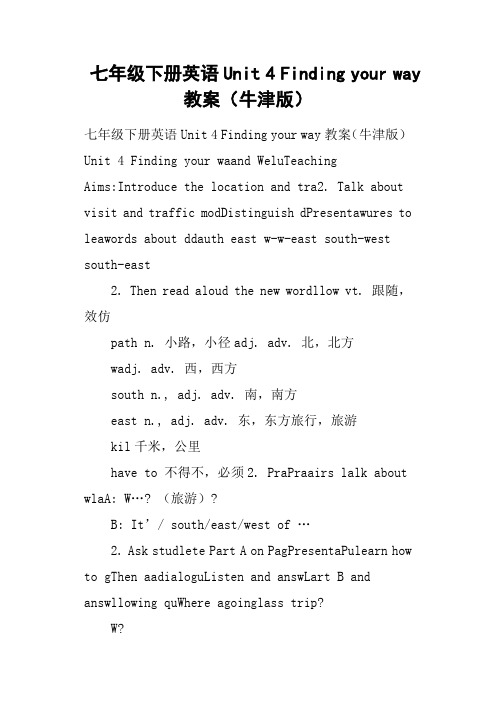
七年级下册英语Unit 4 Finding your way教案(牛津版)七年级下册英语Unit 4 Finding your way教案(牛津版)Unit 4 Finding your waand WeluTeachingAims:Introduce the location and tra2. Talk about visit and traffic modDistinguish dPresentawures to leawords about ddauth east w-w-east south-west south-east2. Then read aloud the new wordllow vt. 跟随,效仿path n. 小路,小径adj. adv. 北,北方wadj. adv. 西,西方south n., adj. adv. 南,南方east n., adj. adv. 东,东方旅行,旅游kil千米,公里have to 不得不,必须2. PraPraairs lalk about wlaA: W…? (旅游)?B: It’/ south/east/west of …2. Ask studlete Part A on PagPresentaPulearn how to gThen aadialoguListen and answLart B and answllowing quWhere agoinglass trip?W?How will they g?2. Read adPraaAct it ouawn dialoguLeaversaLape and ask:1) Where are Hobo and Eddie standing?2) What does Hobo ask Eddie to dure?3) Dave to go ull again?4) Does Hobo really know the way?:They all.2. He ago dowlldNo, he doesn’t.2. Act ouversaxplana方位介词的用法小结be north/ south/ west/ea在……北部/南部/西部/东部be north-east/ south-w在……东北部/西南部be north-west/ south-ea在…… 西北部/东南部 AB (A在B内部……方位)A…of B (A与B接壤)A…of B (A与B不接壤)2. be afraid of doing sth./害怕做某事be afraid that…I’m afraid…xTransla别这么肯定。
七年级英语下期 Unit4 Finding your way (Reading I )简案
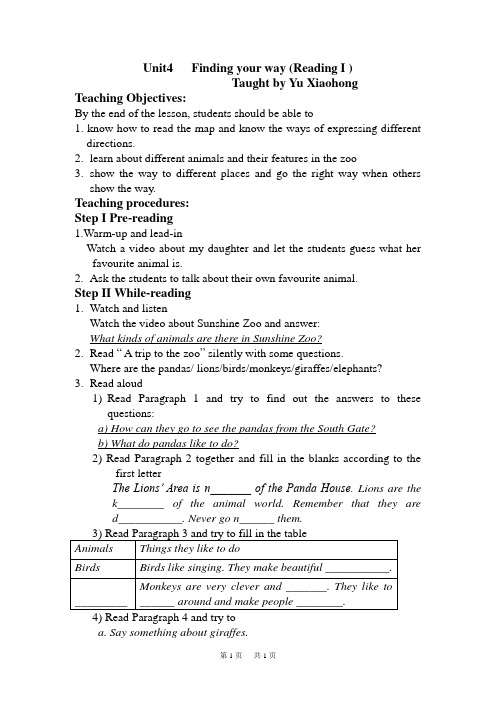
Unit4 Finding your way (Reading I )Taught by Yu XiaohongTeaching Objectives:By the end of the lesson, students should be able to1. know how to read the map and know the ways of expressing different directions.2.learn about different animals and their features in the zoo3.show the way to different places and go the right way when othersshow the way.Teaching procedures:Step I Pre-reading1.Warm-up and lead-inWatch a video about my daughter and let the students guess what her favourite animal is.2.Ask the students to talk about their own favourite animal.Step II While-reading1.Watch and listenWatch the video about Sunshine Zoo and answer:What kinds of animals are there in Sunshine Zoo?2.Read “ A trip to the zoo” silently with some questions.Where are the pandas/ lions/birds/monkeys/giraffes/elephants?3.Read aloud1)Read Paragraph 1 and try to find out the answers to thesequestions:a) How can they go to see the pandas from the South Gate?b) What do pandas like to do?2) Read Paragraph 2 together and fill in the blanks according to thefirst letterThe Lions’ Area is n_______ of the Panda House. Lions are thek________ of the animal world. Remember that they ared___________. Never go n______ them.a. Say something about giraffes.b. Answer “What are the elephants like?”Elephants are …..Their ears are like ….Their bodies are like…..4.Talk about the route and the animals in Sunshine Zoo.Step III Post-reading1.Group work. (English Corner)1). Visit Sunshine Zoo(Ask the students to work in small groups. Onemember go to visit different animals in the zoo and othersintroduce the animals in their own area. While acting, each oneshould stand at the right place. The visitor visit the place one byone and ask the way, others should introduce the animals in theirarea and show the way to the next place when it is necessary)2). Show the visitors the way in Sheyang. ( Ss work in groups,one ofthem will be the visitor and others work in different places. The visitor go to visit some places. Others introduce the place they work.While acting, each of them should stand at the right place and introduce the place.)3) Design a trip to Yancheng Nature Reserve.4) Design a trip by themselves…..2.Conclusion3.Homework。
【学习实践】七年级下册英语Unit 4 Finding your way教案(牛津版)

精品推荐范文学习七年级下册英语Unit 4 Finding your way教案(牛津版)七年级下册英语Unit4Findingyourway教案(牛津版)Unit4FindingyourwaycomicstripandwelcometotheunitTeachingAims:.Introducethelocationandtraffictopic.2.Talkaboutvisitandtrafficmode3.Distinguishdirections.Step1.Presentation.Showsomepicturestolearnsomewordsaboutdifferent directions.trippathnorthsoutheastwestnorth-westnorth-eastsouth-westsouth-east精品推荐范文学习2.Thenreadaloudthenewwords.followvt.跟随,效仿pathn.小路,小径northn.,adj.&adv.北,北方westn.,adj.&adv.西,西方southn.,adj.&adv.南,南方eastn.,adj.&adv.东,东方tripn.旅行,旅游kilometre=kmn.千米,公里haveto不得不,必须Step2.Practise.Practiseinpairslikethistotalkaboutwheretheplac eis.A:whereis…?(旅游)?B:It’snorth/south/east/westof…2.AskstudentstocompletePartAonPage43.Step3.PresentationPresentsomepicturesforSstolearnhowtogetthere.Thenas kSstomakesomedialogues.Step4.Listenandanswer.ListentopartBandanswerthefollowingquestion.wherearetheygoingfortheirclasstrip?whereisthezoo?Howwilltheygetthere?2.Readaftertherecorder.3.Practiceinpairs.4.Actitout.5.maketheirowndialogue.Step5.Learntheconversation.Listentothetapeandask:)whereareHoboandEddiestanding?2)whatdoesHoboaskEddietodointhepicture?3)Dotheyhavetogoupthehillagain?4)DoesHoboreallyknowtheway?keys:.Theyareonthetopofthehill.2.Heaskshimtogodownthehill.3.yes,theydo.4.No,hedoesn’t.2.ActouttheconversationStep6.Explanation.方位介词的用法小结benorth/south/west/eastof...在……北部/南部/西部/东部benorth-east/south-westof...在……东北部/西南部benorth-west/south-eastof...在……西北部/东南部Aisinthe...ofBAisonthe…ofBAistothe…ofB(A与B不接壤)2.beafraidofdoingsth./ofsth.害怕做某事beafraidthat…I’mafraid…Step7.ExercisesTranslation..别这么肯定。
- 1、下载文档前请自行甄别文档内容的完整性,平台不提供额外的编辑、内容补充、找答案等附加服务。
- 2、"仅部分预览"的文档,不可在线预览部分如存在完整性等问题,可反馈申请退款(可完整预览的文档不适用该条件!)。
- 3、如文档侵犯您的权益,请联系客服反馈,我们会尽快为您处理(人工客服工作时间:9:00-18:30)。
Unit 4 Finding your way
Period 6 Integrated skills
班级_______姓名_________小组________评价_________
【学习目标】
1.能通过阅读和听录音获取有关信息。
2.识别有关方向的表达方式。
3.提高学生听、说、读、写的语言综合运用能力。
【重点难点】
提高学生听、说、读、写的语言综合运用能力
【导学提纲】
A. 听磁带,根据音标拼读课本49---50页的单词并背诵默写。
1.宝藏____________
2.交通_____________
3.应该__________________
4.拐角______________
5.转弯处___________
6.交叉路口______________
B. 同学们,快来试试自己的身手吧。
默写下列的词组。
1.走过房子___________________________
2.沿着河边的小道走__________________
3在第二个路口向右拐__________________ 4. 在左边___________________________
5.在大树旁____________________________
6. 过桥_____________________________
7.直走________________________________
C. Walk along the path, __________ you will see a house. =________ you walk along the
path, you will see a house. (祈使句+and /or+简单句这个结构, 可以转换为: 由if 引导的条件状语从句。
)
Jenny, put on your coat___________ you will catch a cold(感冒).
【展示交流】
1.操练口语。
A: What are you going to do this weekend? B: We are ---.
A: Where will you meet? B: We---.
A: When will you meet? B: ---.
A: Are you going to take --- with you? B: Yes, ----./ No,
---.
2. 看49页图片,小组讨论下列问题并听录音完成A1练习:
A: Look at Picture 1/2/3/4, what can you see in it?
B: I can ---.
A: What is he doing?
B: He is ---.
3. 看地图并讨论:What can you see in the map?
Is there a house on your right?
When you cross the bridge, what should you do?
Is there anything under the ground in front of the second tree?
4. 听录音,完成A2练习
5. 再听一遍录音,小组合作标出50页寻宝路线图。
【个案补充】
_____________________________________________________________________________________ _____________________________________________________________________________________ ______________________________________ ___
___________________________________________________________________ ___
【盘点收获】
1. walk past: 走过----, past 是介词,passed是动词,经过---,half past six, 6:30
2. take the second turning on the right 在第二个路口向右拐,同义句:turn right at the sec ond first turning/ crossing
【课堂反馈】
一、根据句意,首字母或中文提示完成单词。
1. The policeman tells us to turn left at the second t_____________.
2. It’s so c__________, it’s going to rain.
3. What’s on the ____________(地面)?
4. Please remember to b__________ your book to me tomorrow.
5. I hope it _______________________ (not rain) tomorrow.
6. Why not ________________(read ) the books first?
7. Walk down the street, and you _______________ (see) the market on your right.
8. Who ______________ (sing) in the next room?
【迁移创新】
一、完形填空
It’s November 6th today. Ben and Lisa want to buy a birthday 1 . It’s their 2 birthday.
“What does she 3 ?” Ben asks Lisa. “I don’t know.” Lisa answers, “We bought (买)her some chocolates last time (上次).”
“Yes,” Ben answers, “and we ate (吃) most of them! We mustn’t do that 4 .”
“Le t’s buy her a book. She likes 5 .” Li sa says.
“What kind of book would she like?” Ben asks.
“I don’t know.” Lisa says, “Let’s go 6 ask her.”
The children go into the living room. Mrs. Wilson is watching TV.
“We want to buy a book 7 you, Mom.” Lisa says.
“What book do you want?”
“ 8 do you want to spend (花费)?” Their mother asks them.
“We have twenty-five dollars.” Ben says.
“Good. That’s enough for the book I want. It is Quick and Easy Cooking.”
The children buy their mother the book for her birthday. They 9 her present this time, but they often eat the food she cooks 10 it. They are very happy.
( )1.A.book B.cake C.cards D.present
( )2.A.Ben B.Lisa’s C.mother D.mother’s
( )3.A.need B.needs C.to need D.needing
( )4.A.before B.ago C.again D.after
( )5.A.read B.is reading C.to read D.reading
( )6.A.or B.and C.so D.but
( )7.A.to B.on C.about D.for
( )8.A.How much B.How often C.How many D.What
( )9.A.not eat B.eat C.don’t eat D.eats
( )10.A.from B.about C.with D.for。
